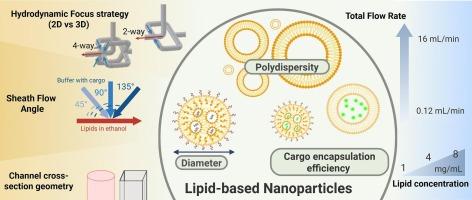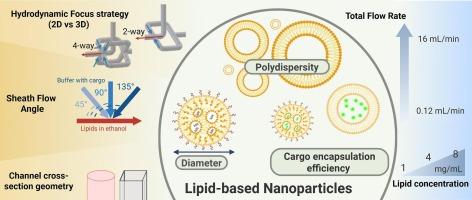Hydrodynamic focusing to synthesize lipid-based nanoparticles: Computational and experimental analysis of chip design and formulation parameters
IF 11.5
1区 医学
Q1 CHEMISTRY, MULTIDISCIPLINARY
引用次数: 0
Abstract
Microfluidic hydrodynamic focusing (HF) has emerged as a powerful platform for the controlled synthesis of lipid nanoparticles (LNPs) and liposomes, offering superior precision, reproducibility, and scalability compared to traditional batch methods. However, the impact of HF inlet configuration and channel geometry on nanoparticle formation remains poorly understood. In this study, we present a comprehensive experimental and computational analysis comparing 2-inlet (2-way) and 4-inlet (4-way) HF designs across various sheath inlet angles (45°, 90°, 135°) and cross-sectional geometries (square vs. circular), assessing their influence on particle size, polydispersity index (PDI), and percentage encapsulation efficiency (%EE) of siRNA and FITC-Dextran. Using 3D-printed microfluidic chips, empty and loaded liposomes and LNPs were synthesized across a range of lipid concentrations (1–8 mg/mL) and total flow rates (0.12–16 mL/min). Computational fluid dynamics (CFD) simulations revealed significant differences in mixing profiles and ethanol diffusion across configurations, correlating with observed nanoparticle properties. Interestingly, 2-way focusing outperformed 4-way designs at low flow rates due to broader diffusive interfaces, while 4-way 45° configurations provided superior control over nanoparticle formation at high flow rates. Circular channels produced smaller, more uniform nanoparticles than square channels, likely due to symmetric flow patterns and reduced stagnation zones. Higher lipid concentrations decreased PDI and improved encapsulation, particularly for siRNA-loaded LNPs. Encapsulation efficiencies were similar across most configurations; however, a statistically significant increase was observed in the 4-way 135° design at 4 mL/min. This likely reflects size-related effects rather than a specific advantage of the configuration. Furthermore, LNPs produced at higher flow rates exhibited enhanced cellular uptake, attributed to their smaller particle size. Overall, our results demonstrate that optimal nanoparticle synthesis via HF is governed by an interplay of flow rate, inlet geometry, and formulation parameters (nanoparticle type and lipid concentration) rather than the number of inlets alone. This study provides a design framework for selecting HF configurations tailored to specific throughput and encapsulation requirements in therapeutic nanocarrier production.


流体动力学聚焦合成脂基纳米颗粒:芯片设计和配方参数的计算和实验分析
微流控流体动力学聚焦(HF)已成为控制合成脂质纳米颗粒(LNPs)和脂质体的强大平台,与传统的批处理方法相比,具有卓越的精度,可重复性和可扩展性。然而,高频进口结构和通道几何形状对纳米颗粒形成的影响仍然知之甚少。在这项研究中,我们进行了全面的实验和计算分析,比较了不同护套进口角度(45°、90°、135°)和横截面几何形状(方形与圆形)下的2入口(2-way)和4入口(4-way) HF设计,评估了它们对siRNA和FITC-Dextran的粒径、多分散性指数(PDI)和百分比封装效率(%EE)的影响。利用3d打印的微流控芯片,在脂质浓度(1-8 mg/mL)和总流速(0.12-16 mL/min)范围内合成了空脂质体和负载脂质体和LNPs。计算流体动力学(CFD)模拟显示,混合剖面和乙醇在不同构型中的扩散存在显著差异,这与观察到的纳米颗粒性质有关。有趣的是,由于更宽的扩散界面,双向聚焦在低流速下优于四向聚焦设计,而四向45°聚焦在高流速下对纳米颗粒形成的控制更出色。圆形通道比方形通道产生更小、更均匀的纳米颗粒,可能是由于对称的流动模式和更少的停滞区。较高的脂质浓度降低PDI并改善包封,特别是对于装载sirna的LNPs。封装效率在大多数配置中是相似的;然而,在4路135°设计中,以4 mL/min的速度观察到统计学上显著增加。这可能反映了与大小相关的影响,而不是配置的特定优势。此外,在高流速下产生的LNPs由于其较小的粒径而表现出增强的细胞摄取。总的来说,我们的研究结果表明,通过HF合成最佳纳米颗粒是由流速、入口几何形状和配方参数(纳米颗粒类型和脂质浓度)的相互作用决定的,而不仅仅是入口的数量。这项研究为选择治疗性纳米载体生产中特定吞吐量和封装要求的HF配置提供了一个设计框架。
本文章由计算机程序翻译,如有差异,请以英文原文为准。
求助全文
约1分钟内获得全文
求助全文
来源期刊

Journal of Controlled Release
医学-化学综合
CiteScore
18.50
自引率
5.60%
发文量
700
审稿时长
39 days
期刊介绍:
The Journal of Controlled Release (JCR) proudly serves as the Official Journal of the Controlled Release Society and the Japan Society of Drug Delivery System.
Dedicated to the broad field of delivery science and technology, JCR publishes high-quality research articles covering drug delivery systems and all facets of formulations. This includes the physicochemical and biological properties of drugs, design and characterization of dosage forms, release mechanisms, in vivo testing, and formulation research and development across pharmaceutical, diagnostic, agricultural, environmental, cosmetic, and food industries.
Priority is given to manuscripts that contribute to the fundamental understanding of principles or demonstrate the advantages of novel technologies in terms of safety and efficacy over current clinical standards. JCR strives to be a leading platform for advancements in delivery science and technology.
 求助内容:
求助内容: 应助结果提醒方式:
应助结果提醒方式:


